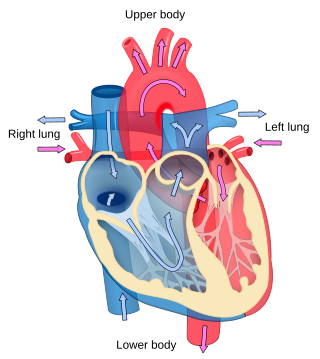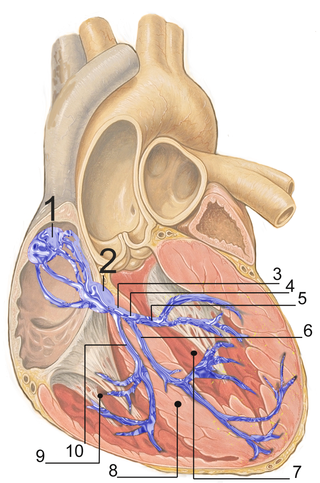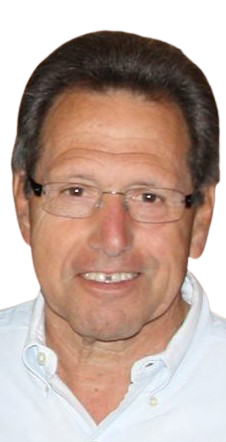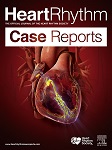Related Research Articles

Cardiology is the study of the heart. Cardiology is a branch of medicine that deals with disorders of the heart and the cardiovascular system. The field includes medical diagnosis and treatment of congenital heart defects, coronary artery disease, heart failure, valvular heart disease, and electrophysiology. Physicians who specialize in this field of medicine are called cardiologists, a sub-specialty of internal medicine. Pediatric cardiologists are pediatricians who specialize in cardiology. Physicians who specialize in cardiac surgery are called cardiothoracic surgeons or cardiac surgeons, a specialty of general surgery.

Cardiac electrophysiology is a branch of cardiology and basic science focusing on the electrical activities of the heart. The term is usually used in clinical context, to describe studies of such phenomena by invasive (intracardiac) catheter recording of spontaneous activity as well as of cardiac responses to programmed electrical stimulation - clinical cardiac electrophysiology. However, cardiac electrophysiology also encompasses basic research and translational research components. Specialists studying cardiac electrophysiology, either clinically or solely through research, are known as cardiac electrophysiologists.
Lown–Ganong–Levine syndrome (LGL) is a pre-excitation syndrome of the heart. Those with LGL syndrome have episodes of abnormal heart racing with a short PR interval and normal QRS complexes seen on their electrocardiogram when in a normal sinus rhythm. LGL syndrome was originally thought to be due to an abnormal electrical connection between the atria and the ventricles, but is now thought to be due to accelerated conduction through the atrioventricular node in the majority of cases. The syndrome is named after Bernard Lown, William Francis Ganong, Jr., and Samuel A. Levine.

In the heart's conduction system, Bachmann's bundle is a branch of the anterior internodal tract that resides on the inner wall of the left atrium. It is a broad band of cardiac muscle that passes from the right atrium, between the superior vena cava and the ascending aorta. Bachmann's bundle is, during normal sinus rhythm, the preferential path for electrical activation of the left atrium. It is therefore considered to be part of the "atrial conduction system" of the heart.
Clinical cardiac electrophysiology, is a branch of the medical specialty of cardiology concerned with the study and treatment of rhythm disorders of the heart. Cardiologists with expertise in this area are usually referred to as electrophysiologists. Electrophysiologists are trained in the mechanism, function, and performance of the electrical activities of the heart. Electrophysiologists work closely with other cardiologists and cardiac surgeons to assist or guide therapy for heart rhythm disturbances (arrhythmias). They are trained to perform interventional and surgical procedures to treat cardiac arrhythmia.

The Punjab Institute of Cardiology (PIC), located in Lahore, Pakistan, is a 547-bed tertiary care hospital. Wither over 1500 staff members, the institute provides cardiac care service nationwide, treating more than 300,000 patients annually.

Pre-excitation syndrome is a heart condition in which part of the cardiac ventricles are activated too early. Pre-excitation is caused by an abnormal electrical connection or accessory pathway between or within the cardiac chambers. Pre-excitation may not cause any symptoms but may lead to palpitations caused by abnormal heart rhythms. It is usually diagnosed using an electrocardiogram, but may only be found during an electrophysiological study. The condition may not require any treatment at all, but symptoms can be controlled using medication or catheter ablation.
The Heart Rhythm Society is an international non-profit organization that promotes education and advocacy for cardiac arrhythmia professionals and patients. The society was founded in 1979 and counted over 7,500 members from over 90 countries as of January 2023. The official journal of the Heart Rhythm Society is HeartRhythm, which provides readers scientific developments devoted to arrhythmias, devices, and cardiovascular electrophysiology. The Heart Rhythm Society is headquartered in Washington, DC, US.

Amiran Shota Revishvili, born February 11, 1956, is a cardiac electrophysiologist, and Director, A.V. Vishnevsky Institute of Surgery in Moscow. He is president of the Russian Scientific Society of Clinical Electrophysiology, Arrhythmology and Cardiac Pacing, which is the Russian organizational member of the European Heart Rhythm Society network.

Mark E. Josephson (1943-2017) was an American cardiologist and writer, who was in the 1970s one of the American pioneers of the medical cardiology subspecialty of cardiac electrophysiology. His book titled Clinical Cardiac Electrophysiology: Techniques and Interpretations is widely acknowledged as the definitive treatment of the discipline. He served as Herman Dana Professor of Medicine at Harvard Medical School, director of the Harvard-Thorndike Electrophysiology Institute and Arrhythmia Service and the chief of cardiology at Harvard University's Beth Israel Deaconess Medical Center in Boston.

Michel Haïssaguerre is a French cardiologist and electrophysiologist. His investigations have been the basis for development of new markers and therapies for atrial and ventricular fibrillation.

Heart Rhythm is a peer-reviewed medical journal published by Elsevier that covers the study and management of cardiac arrhythmia. It is the official journal of the Heart Rhythm Society, the Cardiac Electrophysiology Society, and the Pediatric & Congenital Electrophysiology Society. Its major focus is research and therapy of heart rhythm disorders, including mechanisms and electrophysiology, clinical and experimental, genetics, ablation, devices, drugs, and surgery. Other sections include contemporary reviews, unique case reports, viewpoints, Hands On, images, creative concepts, and editorial commentaries. New sections in 2024 include Iconic Figures and Top Stories.

Henrick Joan Joost Wellens, M.D., (1935–2020) was a Dutch cardiologist who is considered one of the founding fathers of clinical cardiac electrophysiology - a discipline which enables patients with cardiac arrhythmias to have catheter electrode mapping and ablation.
EP Europace is a peer-reviewed medical journal published by Oxford University Press that publishes research articles about the study and management of cardiac arrhythmias, cardiac pacing, and cardiac cellular electrophysiology. It is 1 of 13 official journals of the European Society of Cardiology and is the official journal of the society's working groups on Cardiac Cellular Electrophysiology and e-Cardiology and of the European Heart Rhythm Association.

The Ohio State Richard M. Ross Heart Hospital is located at Ohio State University in Columbus, Ohio. The hospital specializes in cardiology, and is ranked number 46 in the United States for its heart program by U.S. News & World Report for 2020. Care is provided for patients with cardiovascular disease or peripheral vascular disease. The hospital was the first in the country to perform robotic surgery.
Filamins are a class of proteins that hold two actin filaments at large angles. Filamin protein in mammals is made up of an actin-binding domain at its N-terminus that is followed by 24 immunoglobulin-like repeat modules of roughly 95 amino acids. There are two hinge regions; between repeats 15-16 and 23-24. Filamin gets cleaved at these hinge regions to generate smaller fragments of the protein. Filamin has two actin-binding sites with a V-linkage between them, so that it cross-links actin filaments into a network with the filaments orientated almost at right angles to one another.
Pacing and Clinical Electrophysiology (PACE) is a peer-reviewed medical journal that publishes papers in cardiac pacing, clinical and basic cardiac electrophysiology, cardioversion-defibrillation, the electrical stimulation of other organs, cardiac assist, and, in general, the management of cardiac arrhythmias.
Andrea Natale is an Italian-born American cardiologist and electrophysiologist, i.e. a heart rhythm specialist. Natale is known for his work in atrial fibrillation ablation, and he is currently the executive director at the Texas Cardiac Arrhythmia Institute.

Charles Antzelevitch is an American cardiovascular research scientist in the fields of cardiac electrophysiology and cardiac arrhythmia syndromes.

HeartRhythm Case Reports (HRCR) is an online-only, open access medical journal that publishes case reports, images, and educational articles in the field of cardiac arrhythmias and electrophysiology. HRCR is the second peer-reviewed journal from the Heart Rhythm Society and is published by Elsevier.